The State of the Nation - The regional health report in numbers
8-Apr-20084BR looks at the state of the brass band nation - in stark unforgiving numbers. Are we in good health around the country or in the first stages of terminal decline...the stats speak for themselves.
There are of course, lies, damn lies and statistics.
How you interpreter the starkness of figures can be a matter of preference and perception, but you can’t get away from the fact that they are inviolate.
If 57 bands took to the stage at St George’s Hall in Bradford in 1996 then you cannot change that fact. You may interpret it as a healthy total, or one that bodes for potential disaster for the future of Yorkshire banding, but you can’t change the actually factual number.
And that is what 4BR has been doing.
We have looked back over a quarter of a century, from 1983 to date, to find out once and for all what the figures add up to.
Decline or not?
Are we in decline or not? Has the implementation of the First Section in 1992 or even the boundary changes of 1985 had lasting effects for the good or bad of the UK brass band movement in terms of the number of bands that take to the stage at the Regional Championships each year?
It makes for rather stark reading.
Mrs Thatcher and the Miners Strike
The year 1983 is in fact a rather good base point from which to start. The Miners Strike was a year away, starting officially in March 1984, so despite Mrs Thatcher being power since 1979 the full effects the Conservative’s economic and industrial policy was yet to hit the traditional heartlands of the brass band movement.
That movement, although experiencing some difficulties, was still in fairly good health and in the year the strike started 584 bands took to the various regional contesting stages.
Amazingly the immediate years following the Miners Strike saw the number of entries reach a high of 591 in 1988, before the full effects of the biting reality of pit closures and widespread industrial decline brought huge problems to many working class areas of the country.
Slowly at first
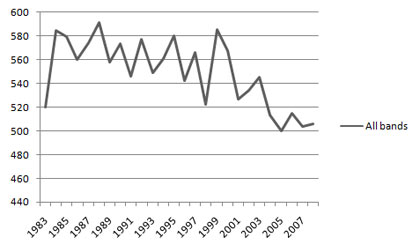
Overall figure: The total number of bands competing at the Regional Championships 1983 - 2008
From 1990 onwards widespread decline started – slowly at first, but with increased rapidity and by 1998 the total number of competing bands had fallen to 522. Despite occasional increased since that date, the general fall has continued, reaching 500 in 2005, with small increases in the following years.
In 2008, 506 bands took part, still an almighty impressive figure it would seem, but one that tells us a great deal about the fragile health of the movement at its present time.
In the first year of the introduction of the First Section in 1992 a total of 577 bands competed in the regional championships. 81 were in the Championship Section; 110 in the new First Section; 124 competed in the Second Section with 134 in the Third. The Fourth Section contained 128 bands.
The structure of the modern contesting movement seemed to be set – a rather well defined pyramid.
Structure
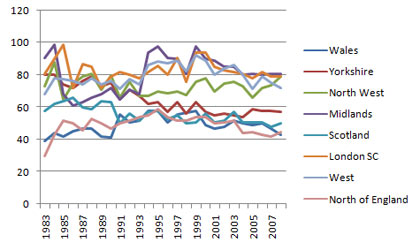
Region by Region: The number of competing bands at each of the eight major regions
However, by 2008 and with just 506 competing bands there were now 86 Championship bands, 100 in the First, 87 in the Second, 106 in the Third and 126 in the Fourth.
71 less bands, but 5 more in the Championship Section, just 10 less in the First, a massive 37 less in the Second, 28 less in the Third and 2 less in the Fourth.
Isn’t that telling us something?
The structure of the Regional Championships has completely changed shape, even though there are less bands competing. Now it resembles a top heavy wedge.
These are the figures we have researched from full results in each of the regions. The figures tell a story no doubt about it:: the interpretation though is up to those who read them…
Yorkshire:
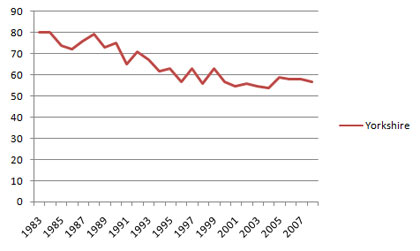
Yorkshire number: The total number of bands at Bradford
Yorkshire with its proud mining tradition was perhaps hit harder than most following the decline of the mining industry.
In 1983, 80 bands took to the stage at St George’s Hall in Bradford, yet by 1998 the number had declined to 56 and today stands at 57.
Conversely the number of Championship bands, which stood at 10 when the First Section was introduced in 1992, reached a peak of 15 in 2004. At the same time the Fourth Section reached its nadir of just 8 entrants. In 1984 the Fourth Section boasted 32 entrants with just 11 bands in the top section.
The First Section has seen a high of 14 bands this year whilst in 1996 it was as low as 8. The Second Section meanwhile has fallen from a high of 19 bands in 1986 to 10 in 2006 and now stands at 11.
The Third Section is now less than half the size it was in 1983 when 21 bands took part, whilst the Fourth has collapsed from 32 to 10.
Wales:
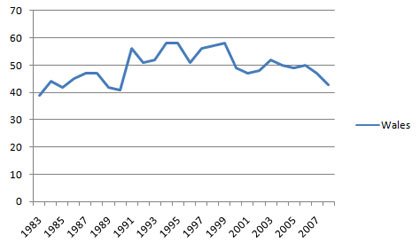
Welsh number: The total number of bands at Swansea
Welsh banding also suffered a number of losses due to the Miners Strike and its associated problems, although the total number of bands has remained fairly constant.
It must be remembered that prior to 1991 North Wales bands competed at the North West Regional Championships, whilst during the period 1991 to 1994 a separate North Wales Area Championship was held.
For the purposes of these Welsh figures, the years 1991 to 1994 have been included in the overall total.
The Championship Section remains fairly static at around 10, but the greatest loss has been felt in the lower sections with a 25 year low of just 16 bands competing in the Third and Fourth Sections this year.
The Championship Section this year saw 9 bands take part, no real change in over 25 years, whilst the same can also be said of the First Section. The Secpnd Section has dropped from a high of 14 in 1985 to a low of 5 in 2002, with a small rise to 9 this year.
The Third Section had as many as 16 bands in 1991 and now boasts 9, slightly up from the last few years, whilst the Fourth was as high as 18 in 1994 and is now down to just 7 this year.
North West:
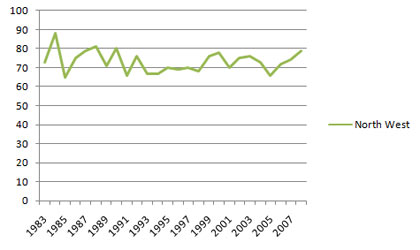
North West number: The total number of bands at Blackpool
The North West appears to have done better than most in retaining the overall number of its competing bands, despite the loss of the North Wales competitors from 1991 onwards.
The number of top section bands has also remained fairly static at around 11, whilst the Third and Fourth Section have also remained in a healthy state with a 18 year high of 43 bands competing this year at the bottom two levels.
The top section has shrunk from a high of 18 bands in 1990 to 11 today, whilst the First Section has remained fairly static at around 13 competing bands.
The Second Section has dropped from a high of 20 competitors in 1984 to 12 today, whilst the Third has remained ain quite remarkable shape at around the 20 mark. The Fourth Section too has done very well, although the days when 38 bands competed in 1984 are long gone.
Midlands:
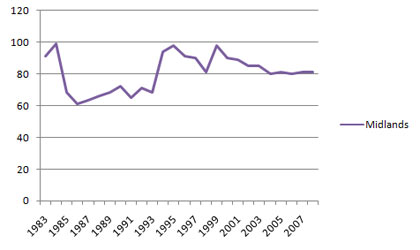
Midlands number: The total number of bands at Burton and Bedford
The Midlands has been the one area of the country that was affected most by boundary changes in 1985 and the combination of the now defunct South Midlands region to the North Midlands region in 1994.
The number of Championship Section bands has remained static at around 12 since 1996, and although there has been a decrease in the overall number of competing bands from a high of 98 in 1999 to 81 this year, the decline has been most felt in the Second Section, which has fallen in numbers from 21 bands to 11.
The South Midlands region figures from 1985 to 1993 are not included in the overall numbers for the Midlands, but are for the overall countrywide totals. Between 1985 and 1993 the smaller region had between a high point of 44 bands in 1989 and a low of 37 in 1993, when the top section boasted just 5 bands.
The amalgamation with the North Midlands in 1994 saw the overall number of bands rise from 68 the previous year to 94, rising to 98 in 1999 and dropping away to the current figure of 81.
The number of top section bands has remained at around the 12 mark for some time now, whilst the First Section remains at a healthy 18 or so. The Second Section has fallen from 24 in 1994 to 11 today, whilst the Third has fallen slightly in the same period from 20 to 17. The Fourth Section remains at a healthy 23 bands, just down from its high water mark of 25 in 2001.
Scotland:
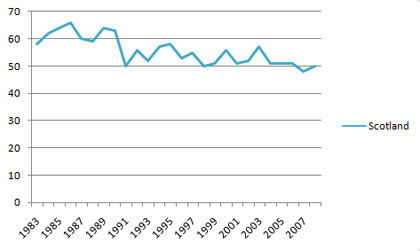
Scottish number: The total number of bands north of the border
Scotland has suffered a significant decline in numbers of competing bands since the end of the Miners Strike.
In 1986, 66 bands competed North of the border, a figure that has gradually declined to its present figure of 50 – a drop of over 20%. The most significant losses have occurred in the Fourth Section, dropping from 22 to 8 bands, although the other four sections have remained fairly static.
The Championship and First Sections have remained static at around the 10 band mark for nearly 20 years, as have the Second and Third. The Fourth Section however has fallen drastically away with a drop of around 60% in competing numbers in 20 years.
London & Southern Counties:
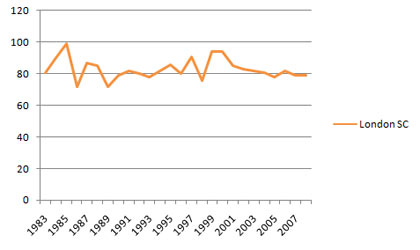
London number: The total number of bands at Stevenage
The massive London & Southern Counties region has lost around 20% of its bands from its high point of 99 competitors in 1985 to the 79 that took to the stage this year.
The Championship and First Section has remained fairly static for the past 15 years or so, but there have been decreases in each of the other sections, with a drop in the Fourth Section from 34 to 22 since 1999.
Nearly 20 of the bands that have featured in the prize lists at Stevenage in the past 15 years did not compete at the 2008 contest.
The top section has dropped in number from a high of 17 in 1991 to the present 12, although the First Section has increased from 11 in 1992 to 15 today. The biggest drops have come in the Second Section (a high of 22 bands in 1985 to 13 today) and the Third (29 in 1985 to 17 today), whilst the Fourth Section has lost over a third of its bands since 1999.
West of England:
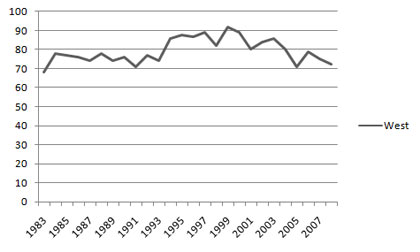
West numbers: The total number of bands at Torquay
Although the West of England remains in fairly robust health the new Millennium has seen a significant decrease in the overall numbers of bands that are competing at the Regional event in Torquay.
In 1999, 91 made the trip to take part, whilst this year the number had dropped to 72 – a fall of around 20%.
The biggest falls have occurred in the lowest three sections during the same period with a loss of 9 bands in the Fourth Section in particular from 1999.
The top section has dropped from a high of 18 bands in 1991 to its present 12, whilst the First Section has also lost a significant proportion of bands, from a high point of 19 in 1992 to 14 today.
The Second Section has lost nearly half its bands since 1995 and so too the Third Section. The Fourth remains fairly healthy although nearly a third of bands have gone since 1999.
North of England:
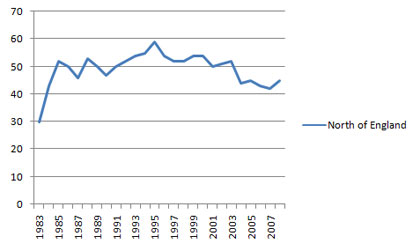
Northern numbers: The total number of bands at Darlington
The North of England has suffered more than most with the after effects of the Miners Strike. The region has lost over 20% of its bands since 1995 when a 25-year high of 1995 took part at the Dolphin Centre in Darlington.
Since then the decline has been slow but steady, with a low point of 42 bands taking part in 2007, although there has been a small increase in bands in the Second and Fourth Sections in the last couple of years.
The Championship remains static at around 8 bands, although the First Section has lost nearly half its number since the high water mark of 1995.
The Second Section has revived itself in the last couple of years but is still significantly smaller than its 1990 high point of 14 competitors, whilst the Third has shrunk by 50% since 1988. The Fourth has also seen a small but encouraging revival.















